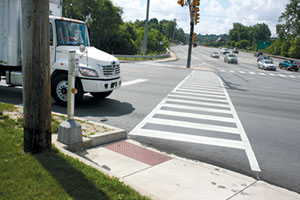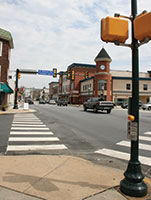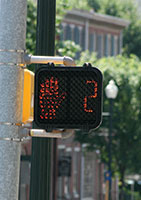Pedestrian Facilities
Pedestrian facilities serve as the very foundation of the multimodal transportation system. The AASHTO Guide for the Planning, Design, and Operation of Pedestrian Facilities states that "Walking is a fundamental form of transportation that is an integral part of the health and livability of our communities. All travelers are pedestrians at some point during their trip. Some travelers make their entire trip on foot, while others walk to catch the bus, or walk between their parking spaces and the front doors of their destinations. Many people also walk for recreation and exercise."
Pedestrian facilities reduce traffic congestion and pollution by providing alternate means to vehicular travel. They also provide recreational opportunities that encourage healthy lifestyles and enhance the quality of life within a community.
This "Pedestrian Facilities" design element refers to walkways, sidewalks, and crosswalks that are to be exclusively used by pedestrians.
Sidewalk
A pedestrian route, typically constructed of concrete and parallel to a street that provides a means for pedestrians to travel within the public right-of-way while physically-separated from vehicular traffic. Sidewalks are designed for pedestrian use only.
Sidewalks
PennDOT's Design Manual 2- Chapter 6: Pedestrian Facilities and the Americans with Disabilities Act (ADA) requires sidewalks to be a minimum of 5 feet in width. This is to comply with the ADA requirement for periodic passing spaces of 5 feet in width thus allowing the entire length of the sidewalk to provide for these spaces.
Title 75 of Pennsylvania's Consolidated Statute prohibits bicycling on sidewalks within business districts, unless expressly permitted by regulatory signage. Planning guidance by PennDOT and AASHTO discourages bicycling on sidewalks, except in the case of young children or in unique circumstances, such as bridges with travel lanes too narrow to safely accommodate bicycle travel.


An active sidewalk/streetscape in West Chester Borough; A sidewalk located along a residential roadway.
The Smart Transportation Guidebook states that "the most fundamental action that can be taken by any municipality to improve pedestrian facilities is to amend its land development ordinance to require the installation of sidewalks for new and redeveloped land uses." The Guidebook further states: "In suburban areas, developers have routinely requested waivers from sidewalk requirements, typically on the grounds that any anticipated pedestrian activity would be minimal. With few exceptions, this should not justify a waiver, given piecemeal suburban development patterns and the constant potential for redevelopment with more intensive uses."
Recommendations
Pedestrian facilities should be included as an integral part of the transportation system within the urban, suburban, suburban center, and rural center livable landscapes as defined by the County's comprehensive policy plan Landscapes2. Municipalities should ensure that subdivision & land development, zoning, comprehensive plans and traffic impact guidelines support the inclusion of pedestrian amenities as outlined herein.
This policy has been established through the adoption of the Public Transportation Plan, an element to Landscapes2. Pedestrian facilities provide many more functions and advantages than just access to public transportation. They provide essential basic connectivity between local destinations as well as recreational opportunities that both contribute to healthy and vibrant communities and provide additional transportation options.
The following exhibit provides an overview of the livable landscapes location and applicability of the pedestrian facilities recommendation.

The following are recommended guidelines to be included in the establishment and/or revisions to any municipal sidewalk related ordinances:
- Sidewalks should have a minimum width of five (5) feet.
- Municipalities with Growth Areas (Urban, Suburban, and Suburban Center) and Rural Center livable landscapes should require by ordinance the installation and maintenance of sidewalks as an integral component of a community's pedestrian network.
- Outside of the Growth Area and Rural Center livable landscapes, sidewalks should be provided on both sides of all roadways in the following locations:
- in all commercial districts;
- where sidewalks and/or pedestrian circulation has been prioritized on any associated policy plan; and,
- within one thousand (1,000) feet of any school, office building, medical institution, commercial use, shopping center, community facility (such as a park or trail) or similar use identified by the governing body.
- The following is a chart of recommended sidewalk and buffer widths for the Landscapes2 growth areas. Buffers are the space between the roadway and sidewalk edges and often include landscape material and/or street furniture depending on their context. Shy distances are the spaces adjacent to fences, buildings, plantings, etc. that pedestrians typically avoid, and only applicable in urban contexts:
| CCPC Functional Class | |||||
|---|---|---|---|---|---|
| Major Arterial | Minor Arterial | Major Collector | Minor Collector | Local Road | |
| Clear Sidwalk Width | 6'-12' urban; 5'-6' suburban |
6'-14' urban; 5'-6' suburban |
6'-10' urban; 5'-6' suburban |
5'-8' urban; minimum 5' suburban | |
| Buffer | 4'-6' urban; 5'-10' suburban | 3'-6' urban; minimum 4' suburban | |||
| Shy Distance | 0'-2' urban; n/a suburban | ||||
Source: Smart Transportation Guidebook
Walkways
Walkways (also known as internal walkways or pedestrian paths) are designed to ensure that pedestrians can avoid using parking aisles or travel lanes for access to building entrances. A walkway is generally used for pedestrian transportation between buildings and parking areas or sidewalks, within parking lots, between buildings on a parcel or within a development, or between adjacent uses, developments, or facilities as shown in the examples below.



An internal walkway in the parking lot of the Government Services Center in West Goshen Township; A system of pedestrian walkways on the campus of West Chester University; Internal walkways within a parking lot, East Whiteland Twp., PA
Walkway
A designated single use facility with an improved surface, primarily for use by pedestrians, typically located outside of the road right-of-way and/or not directly adjacent to a street.
Recommendations
Municipalities should consider requiring walkways within parking areas, and between parking areas and buildings. Where buildings are constructed with a setback or a development that occurs on a parcel where the buildings do not abut a public sidewalk, a requirement for a walkway from the building entrance to the public sidewalk should be required. This requirement may be linked to criteria such as parking lots over a certain size or where a parking lot does not directly abut a public sidewalk.
The following are recommended guidelines to be included in the establishment and/or revisions to any municipal walkway related ordinances:
- Require walkways between:
- building entrances and sidewalks;
- buildings and parking areas;
- adjacent building entrances on the same lot;
- multiple uses on the same lot;
- transit stops and destinations (within 1/4 mile): and/or
- between developments on adjacent parcels.
- Require walkways in parking lots and located within a center island or along the lot's perimeter.
- Require walkways tohave a minimum width of five (5) feet and otherwise constructed to meet PennDOT sidewalk standards, or in accordance with the requirements for a sidewalk within the applicable regulations of the municipal ordinances.
Crosswalks
Crosswalk
A public right-of-way used for pedestrian travel across a roadway at an intersection or any portion of a block (mid-block crossing) to provide safe pedestrian access to adjacent roads, lots, or public use areas.
Crosswalks and pedestrian signals with countdown timers are designed to facilitate safe crossing of roadways. These types of facilities are intended to limit the potential conflict between pedestrians and motorists.
Crosswalks may be either marked or unmarked: a marked crosswalk is any portion of the road outlined by painted markings or a different texture of concrete or pavers to slow and alert drivers, as shown in the following examples.
Signage plays a key role in regard to safety at crosswalks. Drivers must be alert for possible pedestrian activity and stop for pedestrians who are crossing a roadway in a marked or unmarked crosswalk.
Crosswalks are usually marked at intersections where there is a substantial amount of vehicular and pedestrian traffic, such as along school routes and at signalized and four-way stop intersections.



A high-visibility crosswalk at the intersection of US Route 30 Business and PA Route 100 in West Whiteland Township; A high-visibility crosswalk in Downingtown Borough; A countdown timer in West Chester Borough.
High visibility crosswalks are pavement markings that are installed to raise the awareness of motorists to the potential of pedestrians crossing the roadway. There are many different types of pavement markings for high visibility crossings. Zebra crossings (as shown in the photos) are considered to be the most visible crosswalk treatment for both pedestrians and motorists.
Countdown timers are installed in conjunction with walk signals and pavement markings at crossings. Timers warn pedestrians of the time remaining to completely cross the roadway safely before motor vehicles begin to move through the intersection. Timers can be paired with audible cues to benefit sight impaired pedestrians.
See also Mid-Block crossings in the Shared Use Facilities design element.
Recommendations
Municipalities should consider amending ordinances to include requirements for crosswalks. The following are recommended guidelines towards addressing crosswalks in a municipal ordinance:
- Crosswalks shall be installed and maintained as an integral component of the sidewalk network of the [zoning district/other designation] and shall be provided at all intersections of streets and driveways, and at all continuations of sidewalks and paths across streets and driveways.
- All crosswalks shall include roadway signage to indicate a pedestrian crossing.
- Crosswalks shall be a minimum of six (6) feet wide defined through the use of interlocking unit pavers or striped in accordance with the Federal Highway Administration's Manual on Uniform Traffic Control Devices (MUTCD).
General Recommendations
- For facility design guidance, follow the recommendations of PennDOT Design Manual 2- Chapter 6: Pedestrian Facilities and the Americans with Disabilities Act and AASHTO's Guide for the Planning, Design, and Operation of Pedestrian Facilities. Another valuable resource is the ITE publication Designing Walkable Urban Thoroughfares.
- Municipalities should consider amending their zoning and subdivision and land development ordinances to include definitions for pedestrian facilities and clarify these terms across municipal borders. It may also be necessary to delete conflicting definitions and replace wording as appropriate throughout all municipal ordinances.
- Municipalities should incorporate planning for pedestrian facilities in comprehensive plan updates or amendments, special studies and/or official maps.
- Development Process - It is common for municipal officials to place conditions on the approval of subdivision and land development applications. Through negotiation, a municipality can request the installation of pedestrian facilities. The Official Map, ordinance requirements, and other planning elements such as a Comprehensive Plan and/or other adopted plans such as a Bike/Ped Mobility Plan or Greenways Plan will identify the need for these facilities so that developers are aware that the municipality will require or would like to implement these facilities when land development applications are made.
References
- PennDOT Design Manual 2 - Chapter 6: Pedestrian Facilities and the Americans with Disabilities Act
- PennDOT- Bicycle and Pedestrian Checklist - Design Process
- PennDOT - Smart Transportation Guidebook
- American Association of State Highway and transportation Officials (AASHTO) - Guide for the Planning, Design, and Operation of Pedestrian Facilities
- U.S. DOT- Federal Highway Administration (FHWA): Bicycle and Pedestrian Design Guidance
- FHWA Pedestrian and Bicycle Information Center
- Chester County Trail and Path Planning Guide
- PennDOT Pedestrian Facilities Pocket Guide
- PennDOT, Pavement Markings and Signing Standards TC-8600 and TC-8700, Publication 111


